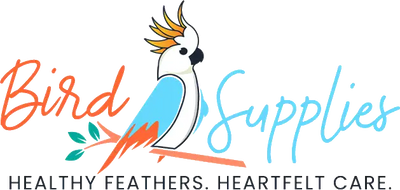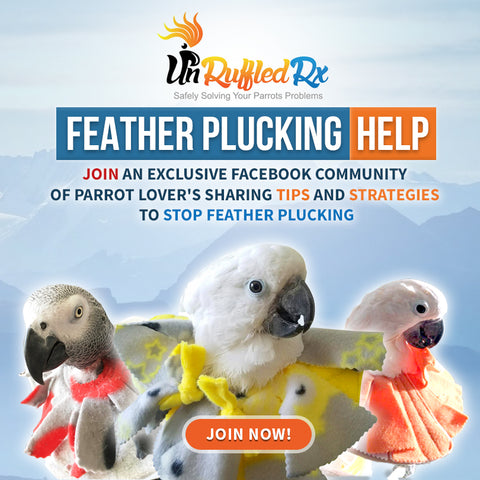Determine the level of parrot plucking
When choosing a bird collar, you’ll need to determine the level of parrot plucking your pet does. Choose a collar that manages that level of plucking but doesn’t restrict any more activities of daily living than necessary. We, at BirdSupplies.com define for levels of parrot plucking, mild, moderate, severe, and self-mutilation.
Mild Parrot Plucking is simply tattered feathers. A hand-reared parrot may have never learned how to preen and use its preening gland. Parrots naturally clean and realign feathers throughout the day. A bird that doesn't know how to preen may do more damage than good in it's preening attempts.
To manage mild parrot plucking, first, consult with your avian vet to rule out a medical issue. Bathe your bird daily get into the habit of rewarding your bird for natural parrot behaviors, such as proper preening versus chewing at feathers, playing, foraging and exercising. Never reward over-preening with attention.
Moderate Parrot Plucking is when the parrot has bald spots on it’s body. Plucking has become a habit. Feather follicles may become damaged resulting in infection and production of curled or defective feathers. Unfortunately, the parrot plucking may become worse over time.
To manage moderate plucking, please consult with your avian veterinarian in to rule out medical problems. You'll want to try a combination of strategies to alleviate the problem, including a using bird collar, re-visiting your parrot husbandry practices, insuring that all environmental needs are met and developing a behavior modification plan to resolve unintended training to pluck.
Severe Parrot Plucking is when most of the body is plucked. Some parrots leave down feathers intact. Severe pluckers are actually addicted to plucking.
To manage severe parrot plucking, you'll need a more restrictive bird collar, as these parrots will do almost anything to destroy feathers. By restrictive, we mean a heavy-duty collar that restricts access to preferred plucking areas. This is accomplished with thick or stiff collars that the bird can’t get around. Plan on trying a variety of collars to find one that your bird tolerates and that restricts access. Keep in mind that restrictive collars impair daily activities such as eating, playing, and exercise, which can further cause the bird to be anxious. You'll also want to carefully assess bird care and parrot husbandry strategies and remove physical and emotional stressors that may induce anxiety.
Self-Mutilation is when a parrot damages the skin and muscle tissue. The habit may start out with the parrot picking at a scab or body injury and it progresses to the bird digging a hole into through the skin and sometimes into muscle tissue. Resolution of the problem is difficult but not impossible. Cooper and Harrison (1994) address that successful treatment is when the behavior is diminished or managed. This video from Chloe Sanctuary is great resource for helping you know how to handle self-mutilation.
COMPARE 5 STYLES OF BIRD COLLARS:
- Saf-T Shield Lexan Bird Collar - a stiff, clear plastic collar with a snap on fastening system and padded neck.
- UnRuffledRx Slip-on Style - A fleece bird collar that provides a barrier between your birds beak and it's chest, wings, back and legs. The mild collar slips over your bird’s head. Four (4) layers of soft fleece deter birds that simply pick at feathers and over-preen. It is not thick enough to deter plucking and picking that has become obsessive in nature.
- UnRuffledRx Velcro Closure - This fleece collar provides a thicker barrier for the more determined picker and plucker. Featuring 5-6 layers of thick fleece, the determined bird has to work to get this collar off. With newly reinforced Velcro enclosure to deter ripping off the Velcro,
- UnRuffledRx Leather for Severe Pickers- Is your bird driven to pluck or self-mutilate? Do you need to insure that your bird doesn't rip stitches out from surgery? This is the collar for you. With a 1.4 to 2.0 mm thick supple vegetable tanned leather base and super-stitched Velcro fastening system, and topped off with two layers of fleece to preen (optional), thereby distracting your bird from its own body, this is the sturdiest bird e-collar on the market.
- Fringy Collar: Our Fringy Collar is a very thick fleece collar with a stiff insert. It is designed for severe pluckers and mutilators.
- Parrot Poncho: This cowl neck parrot poncho slips over your parrots head and cinches with a Vet-tan leather tie to protect your bird's neck area, under wings and other vulnerable areas. Available in stylish fabrics.
- NeckBand Tube Collar: Use our NeckBand Tube Collar for birds that neck pick or that require restricted head movement to prevent picking of vulnerable body parts. The Veg-tan leather insert provides a supple stiffness while the fleece cover is soft on the neck. Adjustable Velcro closure can be cut to size.
|
Collar Style |
Materials |
Thickness |
Fastening |
Need |
|
Saf-T Shield |
Lexan Plastic |
|
Adjustable Snaps |
Plucking, Mutilation, Post Surgery |
|
UnRuffledRx Mild |
Anti-pill Fleece |
3-4 Layers |
Slips Over Head |
Picking, Plucking, Minor Wound Protection |
|
UnRuffledRx Moderate |
Anti-pill Fleece |
4-6 Layers |
Super Stitched Velcro |
Plucking, Mutilation, Post Surgery |
|
UnRuffledRx Leather |
Supple Veg Tan Leather; May be topped with 2 layers of anti-pill fleece |
Leather - 1.4 - 2.0 mm 2 Layers Fleece (optional) |
Super Stitched Velcro |
Plucking, Mutilation, Post Surgery |
 |
COMPARE SOFT APPAREL FOR PARROT PLUCKING
|
Product |
Materials |
Thickness |
Fastening |
Need |
|
Cotton Cloth |
Thin |
Tie |
Fashion, mild plucking, getting used to wearing apparel |
|
|
Feather Protector |
Lightweight anti-pill Fleece; elastic shoulder straps |
2-3 Layers |
Velcro along back |
Picking, Plucking, Minor Chest Wound Protection |
|
Parrot Poncho |
Anti-pill Fleece; Veg-tan leather tie; Cowl Neck |
3-4 Layers |
Super Stitched Velcro |
Plucking, Mutilation, Post Surgery; Protects the Neck |







